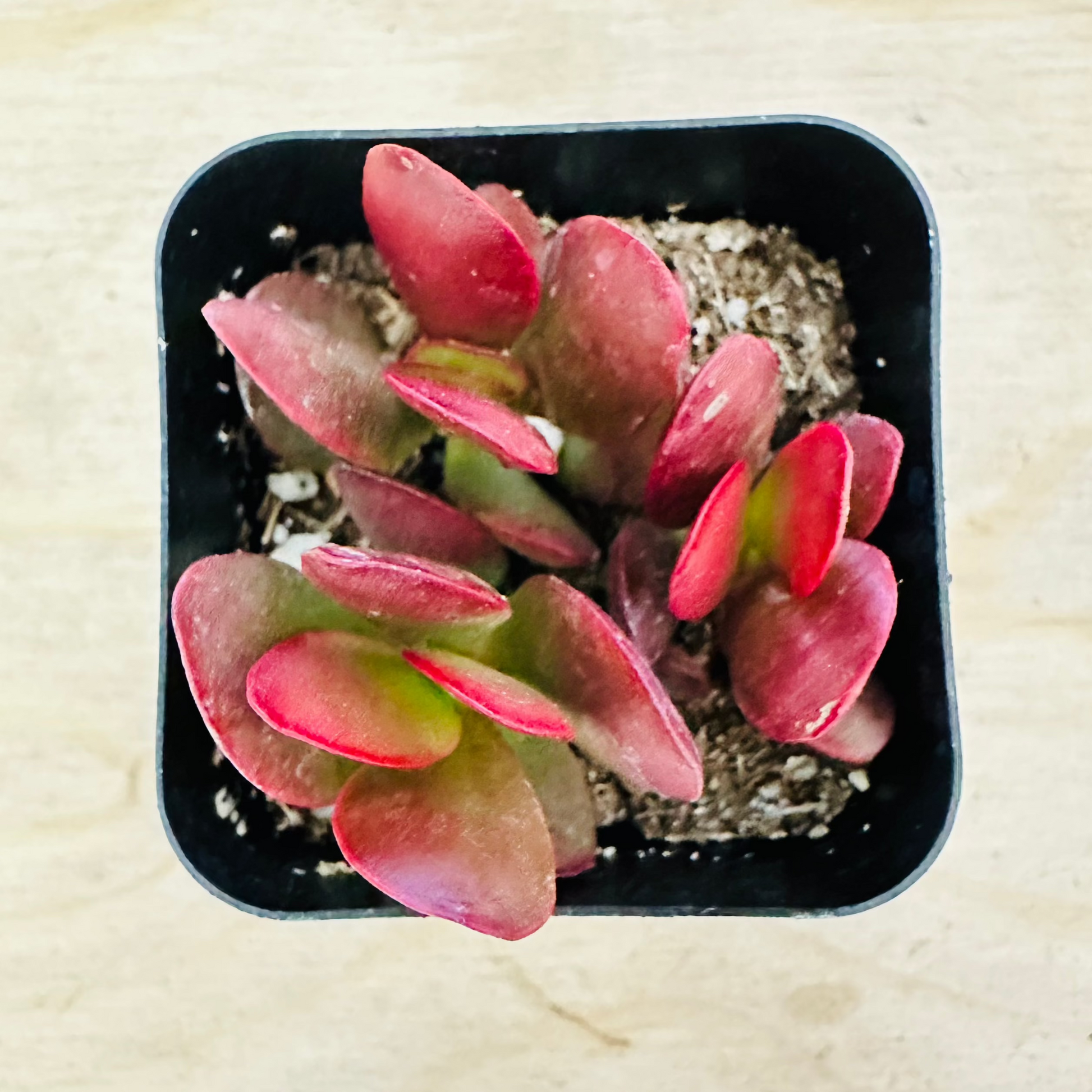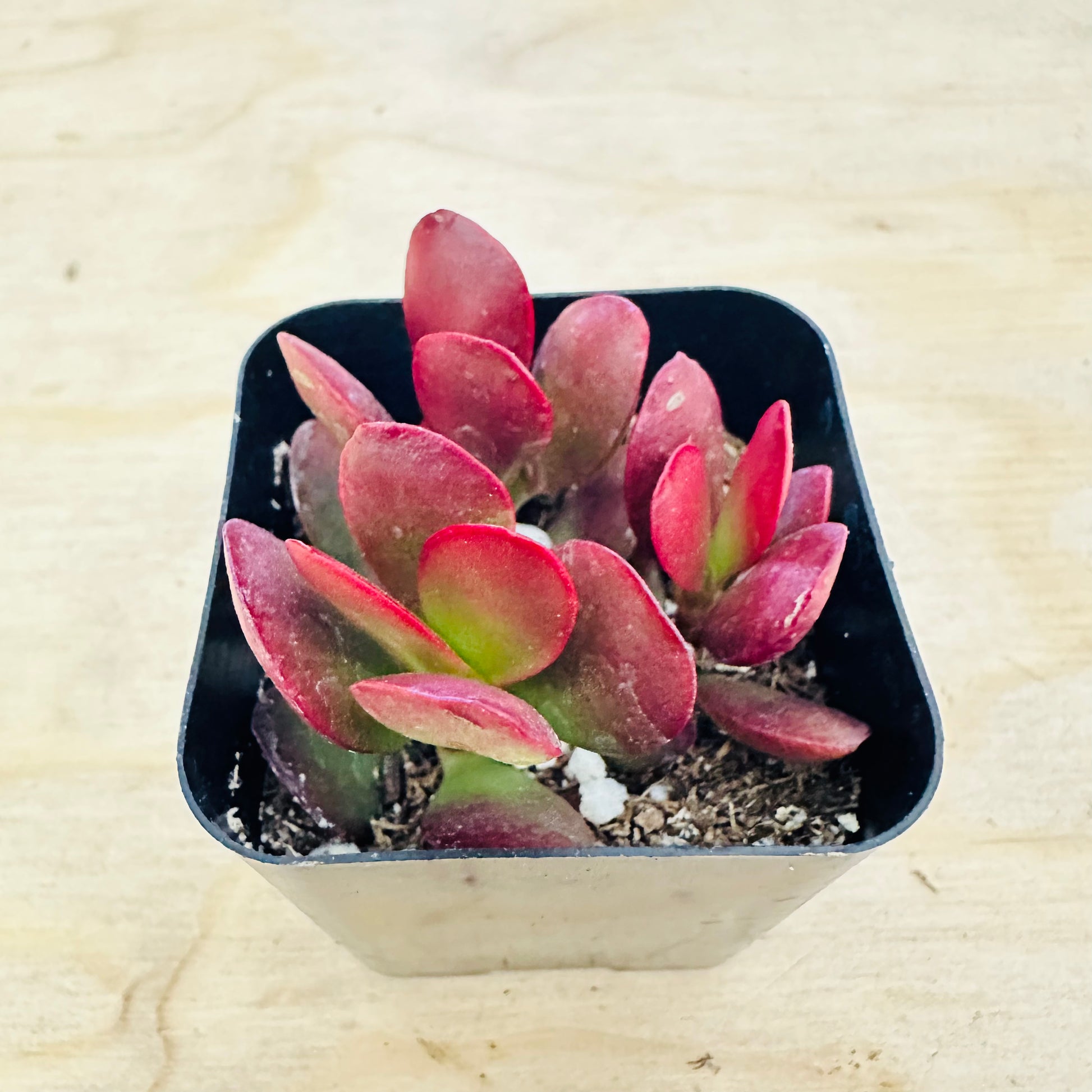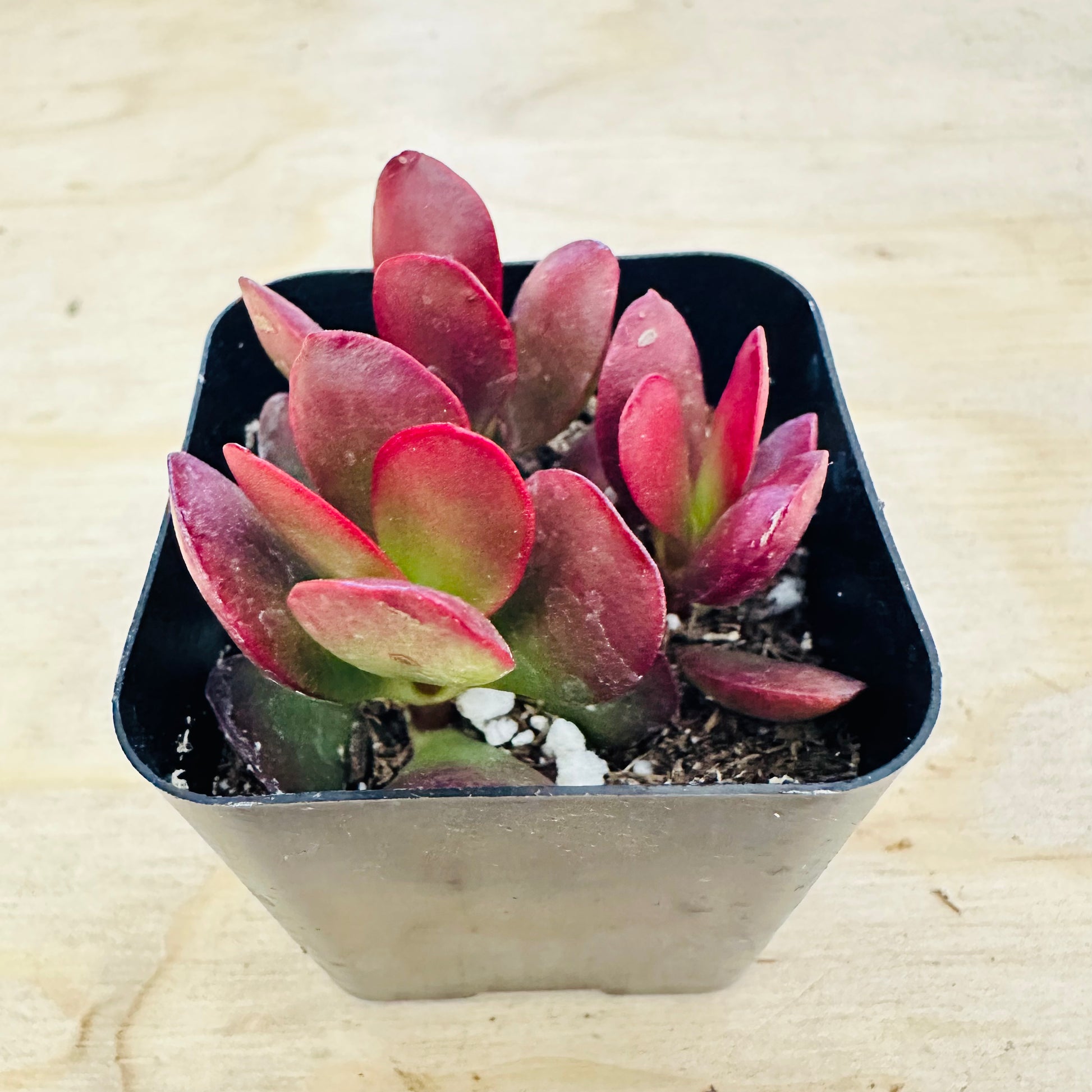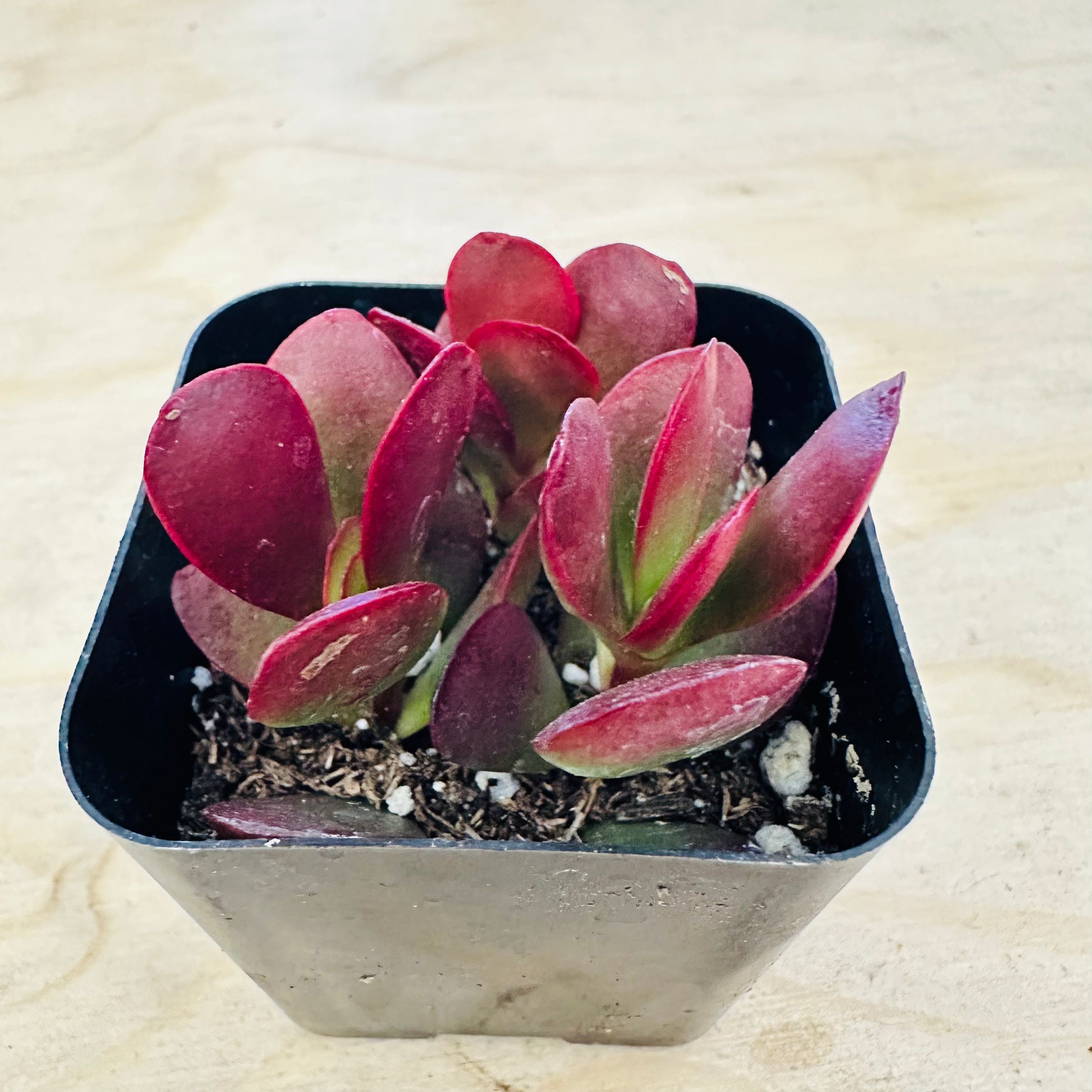Crassula pubescens ssp. radicans - Large Red Carpet Stonecrop
Crassula pubescens ssp. radicans - Large Red Carpet Stonecrop
In stock
Couldn't load pickup availability
📝 Description
Morphological Characteristics
Crassula pubescens subsp. radicans, commonly known as Large Red Carpet Stonecrop, is a low-growing succulent in the Crassulaceae family, native to South Africa. It is admired for its vivid foliage color changes, sprawling habit, and adaptability in both containers and ground cover use.
This succulent features small, ovate leaves that are green under moderate light but turn rich crimson-red when exposed to bright sunlight or cool temperatures. The leaves grow in opposite pairs along thin, branching, trailing stems that root easily at nodes, forming dense mats.
Mature plants typically grow only 5–10 cm (2–4 inches) tall but may spread 30–60 cm (12–24 inches) or more horizontally. In late fall to early spring, it produces small, star-shaped, yellow flowers in tight terminal clusters above the foliage.
Growth Habits
Crassula pubescens ssp. radicans is a fast-spreading, ground-hugging succulent with a mat-forming growth habit. It’s ideal for cascading over pot edges, covering rocky garden areas, or adding vibrant contrast in succulent arrangements. The plant thrives in dry, sunny conditions and is well suited for xeriscaping or hanging planters.
Maintenance Points
-
Lighting: Requires bright light to full sun to maintain compact growth and vibrant red coloration. Partial shade may result in greener, less colorful leaves.
-
Watering: Water thoroughly but infrequently. Let soil dry out completely between waterings. Less water is needed during winter dormancy.
-
Soil: Use sandy, well-draining cactus or succulent soil. Amending with perlite or coarse sand is beneficial.
-
Temperature: Best grown between 18–29°C (65–85°F). Can tolerate light frost briefly, but prolonged exposure below 5°C (41°F) should be avoided.
-
Fertilization: Feed monthly with a diluted cactus or succulent fertilizer during the active growing season (spring through early fall).
-
Potting: Ideal for shallow containers with drainage. Can be used as a spiller in mixed pots. Repot when the plant becomes too crowded or woody at the base.
-
Humidity: Prefers dry air and good airflow. Avoid excess humidity to prevent fungal issues.
Reproduction Method
Stem Cuttings:
-
Cut 5–8 cm (2–3 inch) segments of healthy stems.
-
Allow cut ends to callus for 1–2 days.
-
Plant in dry, well-draining soil and water sparingly until roots form.
Division / Layering:
-
Lift and divide mature clumps or rootable branches.
-
Replant directly into soil and water lightly.
Seeds:
-
Rarely propagated by seed. If used, sow thinly over moist, gritty soil and keep warm in indirect light.
Additional Tips
-
Pest Control: Watch for aphids, mealybugs, and fungal gnats in wet conditions. Treat infestations early with neem oil or insecticidal soap.
-
Disease Prevention: Ensure quick drainage and avoid letting water sit on leaves or in containers. Good ventilation is important.
-
Pruning: Trim back overly leggy or woody stems to rejuvenate growth and maintain a dense carpet form.
-
Display: Excellent in rock gardens, low-profile containers, or as a bright red accent in succulent combinations.
-
Safety Note: Generally considered non-toxic to pets and humans, but best kept out of reach of curious animals.
🌿 Care Tips
Plant Care
Light
Water
Soil
Temperature
Hardiness
Fertilizer
Propagation: Leaf/offset cuttings
Common issues: Etiolation, mealybugs, rot
🌟 Note: It’s normal for succulents to appear slightly shriveled after shipping. They usually recover within a few days in a suitable environment.
📦 Shipping Info
Seah Shipping Policy
Effective Date: November 2025
This Shipping Policy applies to orders delivered within the continental United States (the lower 48 states). By purchasing from Seah, you agree to the terms below.
1) Shipping Cost & Free Shipping
- Automatic rate calculation: Shipping is calculated at checkout based on weight, destination ZIP and carrier rates.
- Free Standard Shipping: Orders $59+ (pre-tax, after discounts) ship free to the lower 48 states.
- Alaska, Hawaii, Puerto Rico & other territories: Not eligible for free shipping or standard flat offers at this time.
- Taxes/Duties: Applicable sales tax and any fees are shown at checkout.
2) Processing Schedule
- Business days only: We process and ship Monday–Friday. No shipping on weekends or U.S. federal holidays.
- Handling time: 1–3 business days after payment confirmation.
- Cut-off time: Orders placed before 3:00 PM (PST) are prioritized for same-day processing; others roll to the next business day.
- Changes/Cancellations: Email support@seah.co within 12 hours of purchase; after that, the order may already be in processing.
3) Transit Times
| Method | Estimated Transit | Total ETA (Handling + Transit) |
|---|---|---|
| Standard | 5–8 business days | 6–11 business days |
| Express | 3–4 business days | 4–7 business days |
ETAs are estimates. Weather, holidays, carrier delays or high-volume periods may extend delivery times.
4) Seasonal Temperature & Plant Safety
- Winter (Nov–Mar): We strongly recommend adding a heat pack at checkout to protect plants from freezing. Orders shipped without a heat pack during cold conditions are not covered for cold damage.
- Summer heat: During extreme heat waves, we may hold shipments until temperatures normalize. We’ll notify you if there’s a hold.
- Packaging: Plants are carefully packed (bare-root or potted by type/size) to minimize transit stress.
5) Carriers & Tracking
- We ship via USPS / UPS / FedEx, selected automatically for best service to your address.
- When your order ships, you’ll receive a tracking email. Tracking typically activates within 24 hours.
- If you haven’t received tracking within 3 business days, contact us at support@seah.co or +1 (626)-999-1314.
6) Address Changes & Delivery Issues
- Before shipment: Request address changes within 12 hours of ordering.
- After shipment: We can’t modify the address once dispatched. Please contact the carrier for redirection options.
- PO Boxes: Supported for USPS only; UPS/FedEx require a street address.
- Seah isn’t responsible for delays or loss due to incorrect addresses provided at checkout.
7) Service Area
We currently ship to the continental U.S. (lower 48 states). Orders to AK/HI/PR and other territories are not eligible for free shipping and may be restricted.
8) Support
- Hours: Mon–Fri, 9:00 AM – 5:00 PM (PST)
- Phone: +1 (626)-999-1314
- Email: support@seah.co
- Address: 7870 Margaux Pl, Rancho Cucamonga, CA 91739, United States
Thank you for supporting our California nursery—each plant is hand-selected and packed with care. 🌱














